
Italian postcard by CR / Diffida ASC, no. 2. Photo: Varischi Artico & C., Milano. Sent by mail in 1903.
Italian postcard by ENCV.

Italian postcard by Unione Bromografica, Milano, no. 16.

Italian postcard by G.B. Falci, Milano, Series 212. Portrait by C. Monestier.

Italian postcard by Ed. A. Traldi, Milano, no. 301. Photo: A. Badodi, Milano.

Italian postcard by Ed. A. Traldi, Milano, no. 302. Photo: A. Badodi, Milano.
Flashing blue eyes
Dina Galli was born as Clotilde Annamaria Galli in Milan, Italy in 1877. She was a real figlia d'arte. Her mother was an actress and as a little girl, Dina already played small parts for her mother's theatre companies.
With her flashing blue eyes, her pointed face, her slender figure and her gentle irony, she soon conquered the Italian stage. In 1890, she joined the theatre company of Edoardo Ferravilla, the great actor of the Milanese dialect. There she showed a great talent for comedy and soon she played leading roles.
A decade later she managed to enter the renowned Talli-Grammatica-Calabresi theatre company with the young Ruggero Ruggeri. For years she excelled in the frivolous and spicy comedies by Georges Feydeau, Maurice Hennequin, Pierre Veber et. al., such as 'La Dame de chez Maxim'.
La Dina became the darling of both the critics and the public. During the First World War, she obtained successes with 'La Maestrina' (The Teacher) and 'Scampolo', both by Dario Niccodemi. Galli took sidesteps into the silent cinema during the First World War and appeared in Veli di giovinezza/Veils of Youth (1914), La monella/The Brat (1914) and L'ammiraglia/The Flagship (1915). All three films were directed by Nino Oxilia, who was killed during the war.
In 1917 followed Le nozze di Vittoria/The Wedding of Victoria (Ugo Falena, 1917). After that, Galli focused on dramatic roles in stage plays, in particular the dialectical theatre by Giuseppe Adami. In these productions, Galli talked in vernacular Milanese, as in 'Felicita Colombo' (1935), the role that stuck to her.

Italian postcard by ASC Diffida / CR, no. 6. Sent by mail on 27 November 1903.

Italian postcard by RA, no. 2144. Photo: Varischi Artico & C., Milano.

Italian postcard by LTK. Photo: Camuzzi Lomazzi, Corso Venezia, Milano.
Italian postcard. Caricature by Girus (Giuseppe Russo). It was exposed in 1914 at the first international exhibition of caricatures and humorism in Italy.

Italian postcard by Tip. Teatr. & Comm., Torino, Dina Galli in the play 'Scampolo' (1915) by Dario Niccodemi. The painter Carlo Stratta would paint a portrait of Galli based on the photo for this card. Niccodemi would write a novel (1918) based on the play, while several film adaptations would follow with a.o. Carmen Boni and Romy Schneider.
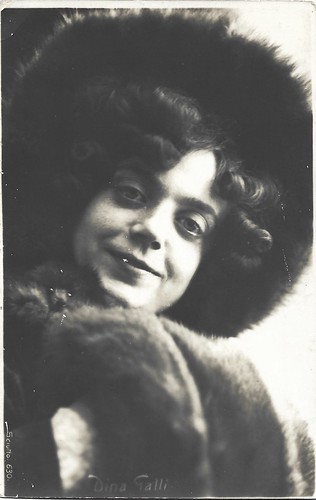
Italian postcard, no. 630. Photo: Sciutto, no. 630.
One of Fellini's favourite actresses
From the late 1930s on, Dina Galli regularly acted in the Italian sound cinema. The films Felicita Colombo (Mario Mattoli, 1937) and Nonna Felicita/Grandmother Felicita (Mario Mattoli, 1938) with Armando Falconi were both based on the stage successes of Galli and showed her comedy skills.
Other films she played in were Nini Falpalà (Amleto Palermi, 1933), Frenesia/Frenzy (Mario Bonnard, 1939), La zia smemorata/The Forgetful Aunt (Ladislao Vajda, 1941), and Il sogno di tutti/The Dream of Everything (Oreste Biancoli, Laszlo Kish, 1941).
Then followed Stasera niente di nuovo/Nothing new tonight (Mario Mattoli, 1942) with Carlo Ninchi and Alida Valli, I biricchino di papà/The fluffy Dad (Raffaele Matarazzo, 1943), and Tre ragazze cercano marito/Three Girls Looking for Husbands (Duilio Coletti, 1944) with Carla del Poggio.
After the war, she acted in Lo sbaglio di essere vivo/My Widow and I (Carlo Ludovico Bragaglia, 1945) starring Vittorio De Sica and Isa Miranda, Vanità/Vanity (Giorgio Pastina, 1946), and Sambo (Paolo William Tamburalla, 1950) with Paolo Stoppa. Her last, uncredited, role was in I cadetti di Gascogna/The Cadets of Gascony (Mario Mattoli, 1950) starring Walter Chiari. In 1945, Galli returned to the stage with comedies such as Noel Coward's 'Blythe Spirit' by George Kaufman and Moss Hart, together with Rina Morelli, and 'Arsenic and Old Lace' by Kesserling.
She was one of Federico Fellini's favourite actresses. Her last performance was in the revue 'Quo Vadis? (1950), with Enrico Viarisio. Dina Galli died in Rome in 1951. She was 73. In 2022, Mariagabriella Cambiaghi and Raffaele De Berti published a new, Italian study on Galli, 'L'ambrosiana pura. Dina Galli attrice di teatro, cinema e radio' (Mimesis Edizioni).

Italian postcard by G. Ballerini & C. Editori, Firenze, no. 603/3. Photo: Massaglia, Torino.

Italian postcard by G. Ballerini & C. Editori, Firenze. no. 603/4. Photo: Massaglia, Torino.
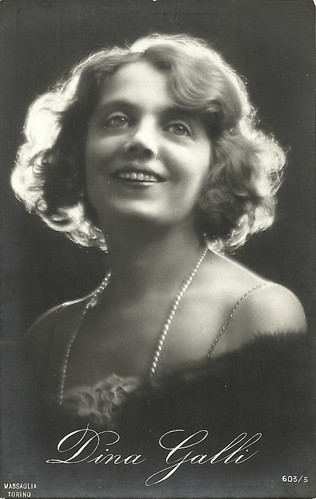
Italian postcard by G. Ballerini & C. Editori, Firenze. no. 603/5. Photo: Massaglia, Torino.
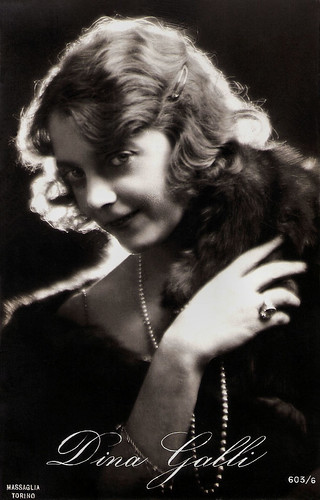
Italian postcard by G. Ballerini & C. Editori, Firenze, no. 603/6. Photo: Massaglia, Torino.

Italian postcard.

Italian postcard by I.C.A.R. (Generalcine). Dina Galli in the Italian comedy Nonna Felicità (Mario Mattoli, 1938). It was a sequel to the 1937 film Felicità Colombo, again by Mattoli.
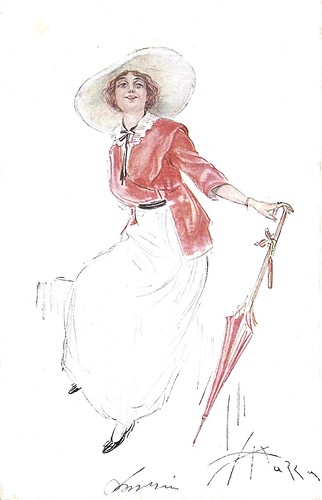
Italian postcard by Alfieri & Lacroix, Milano, no. 1810. Design by Aldo Mazza.

Vintage Italian postcard by Societa' Editricie Cartoline, Torino. Caricature by Efenty [?] of the stage company Sichel Galli Guasti, led by cav. Giuseppe Sichel, Dina Galli and Amerigo [the L. on this card is an error] Guasti. Also visible on this card: Ignazio Bracci and Stanislao Ciarli. In 1906-1907, Sichel formed this company, named Compagnia dei cinque, which was one of the most significant in Italy at the time.
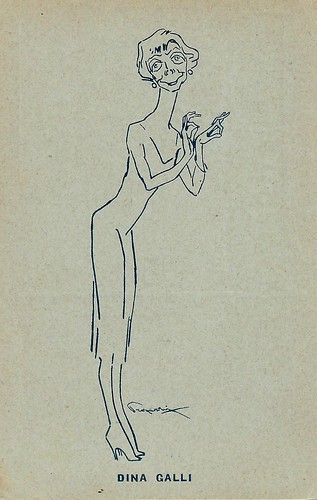
. Italian postcard, edited by the journal Le Maschere. Caricature by Sandro Properzi.

Italian postcard by Ed. Art. Alberani (Frutta Alberani). Design by Nanni.

Italian postcard by I.G.A.P. Roma. Caricature by Onor. Collection: Marlene Pilaete.
A segment of Luce Journal after the death and funeral of Dina Galli in 1951. Source: CinecittaLuce (YouTube).
Sources: Sipario.it (Italian), Mymovies.it (Italian), Wikipedia (Italian) and IMDb.
No comments:
Post a Comment